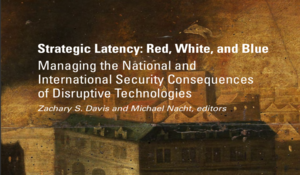Strategic Latency: Red, White, and Blue- Managing the National and International Security Consequences of Disruptive Technologies

“Strategic Latency: Red, White, and Blue- Managing the National and International Security Consequences of Disruptive Technologies“
Speakers: Canton, J. (Institute for Global Futures); Davis, Z. (Lawrence Livermore National Laboratory (LLNL)); Gac, F. (LLNL); Giordano, J. (Georgetown University); Snow, J. (USSOCOM J5 Donovan Group)
Date: 7 May 2019
Speaker Session Preview
SMA hosted a panel discussion as a part of its SMA SOCOM Speaker Series. The speakers on this panel were Dr. Zachary Davis (Lawrence Livermore National Laboratory (LLNL)), Dr. James Giordano (Georgetown University), Mr. Wes Spain (LLNL), Dr. James Canton (Institute for Global Futures), Lt Col Jennifer Snow (USSOCOM J5 Donovan Group), and Dr. Frank Gac (LLNL).
To begin, Dr. Davis defined strategic latency as “the potential for technology—new or old—to be exploited in ways that shift the global balance of power.” He then explained the theoretical framework behind the panelists’ book, entitled Strategic Latency: Red, White, and Blue. “Red” refers to threat analysis and includes both foreign threats and strategic warning. “White” refers to the neutral/dual-use nature and study of technology over time. “Blue” refers to current efforts by the US government to procure technologies in a timely manner. Dr. Giordano then assessed the viability of China as a global exemplar of neuroscience and neurotechnology research and development (R&D). He discussed China’s plans for the future with respect to biotechnological and neurotechnological research, as well as the implications for strategic latency. Next, Mr. Spain examined “dogs that haven’t barked,” or threats that decision-makers have witnessed in the national security domain that have not manifested in the way in which they were forecasted. He also discussed the difficulty of providing timely and accurate forecasts, as well as the “blue” implications of his assessment. Dr. Canton then discussed emerging trends in big data and artificial intelligence (AI), as well as the potential exploitation of these technologies and implications for the intelligence community (IC). Lt Col Snow proceeded to highlight the ways in which 3D printing can be used for malicious purposes and argued that a balanced, inclusive discussion about technology threat vectors is necessary, from a national security perspective. Dr. Gac concluded by discussing public-private partnerships, particularly with respect to the development of national security. He explained the spectrum of partnerships and identified which types of partnerships have worked in the past.
Comments